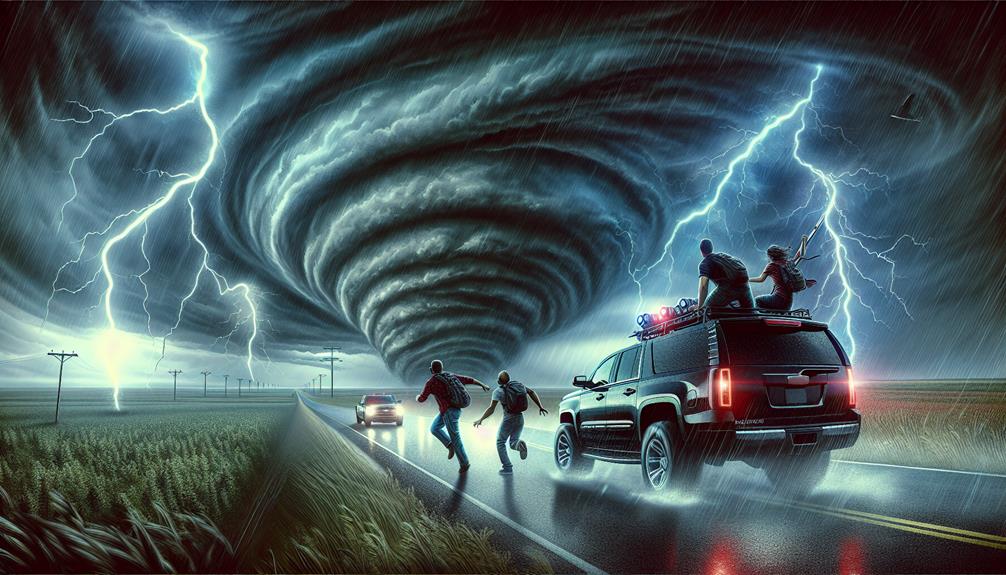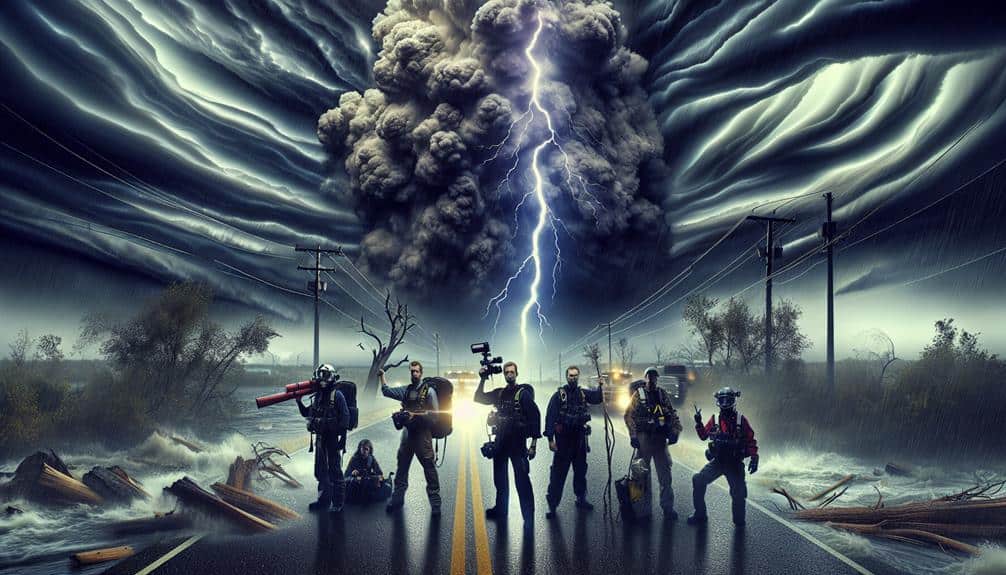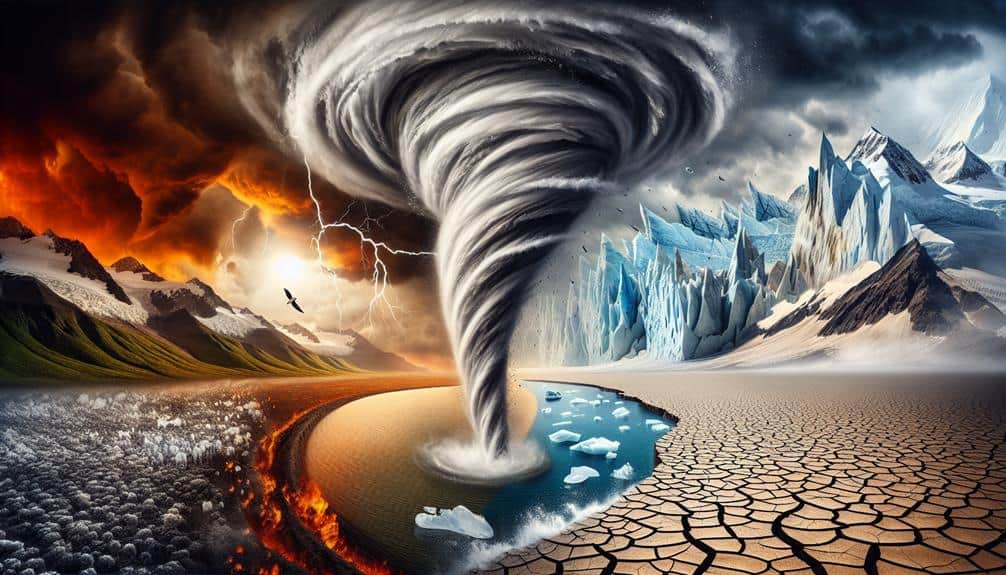As storm chasers, we're deeply concerned about climate change because it's directly linked to more frequent, intense, and unpredictable storms. Rising global temperatures boost storm intensity, making them more powerful with higher wind speeds and extreme precipitation. These shifts lead to altered storm paths and seasons, complicating our tracking efforts. The changed storm behavior poses significant safety risks and challenges in forecasting. Adapting our methodologies to these evolving patterns is essential. Additionally, the dire environmental impacts of more severe storms highlight the urgency of understanding these changes. By staying informed, we can better navigate the storm-chasing landscape.
Key Points
- Rising global temperatures increase storm intensity, posing greater risks for storm chasers.
- Unpredictable storm movements due to climate change complicate tracking and safety measures.
- Enhanced storm frequency and severity heighten the danger and unpredictability for storm chasers.
- Altered storm seasons and paths require adaptive strategies and continuous monitoring.
Rising Global Temperatures
We've observed that rising global temperatures directly correlate with an increase in the frequency and intensity of severe weather events. This isn't just a hypothesis; it's supported by robust data.
As temperatures climb, the atmosphere holds more moisture, fueling more powerful storms and altering precipitation patterns. This shift results in more extreme weather events, like intense heatwaves, heavy rainfall, and prolonged droughts.
The impacts on the environment are profound. For instance, heatwaves exacerbate drought conditions, stressing water supplies and challenging agricultural productivity. Meanwhile, heavy rainfall events lead to flooding, which not only damages infrastructure but also disrupts ecosystems and displaces communities. These extreme weather events create a cycle of environmental stress, affecting everything from wildlife habitats to human livelihoods.
In our quest for freedom, it's critical to understand these dynamics. The increasing frequency of severe weather events driven by rising global temperatures can restrict our ability to live freely and safely.
Changing Storm Patterns
As storm chasers, we've observed an increase in storm frequency, with data indicating a notable rise in the number of severe weather events.
Additionally, storm intensity has shifted, with more storms reaching higher categories and causing greater damage.
The timing of storm seasons is also changing, leading to unpredictable patterns and extending periods of storm activity.
Increased Storm Frequency
Analyzing recent meteorological data reveals a significant uptick in storm frequency, indicating a shift in global storm patterns. This trend presents both challenges and opportunities for us as storm chasers. On one hand, increased storm frequency necessitates stricter safety measures to protect ourselves and those we encounter. On the other hand, it offers valuable research opportunities to better understand the impacts of climate change on weather systems.
The data shows:
- More frequent severe thunderstorms
- Increased occurrences of tornadoes
These patterns compel us to adapt quickly. Our safety measures must evolve to match the rising frequency of storms, ensuring that our pursuit of storm data doesn't compromise our well-being.
As storm chasers, we're not just thrill-seekers; we play a critical role in capturing data that can lead to improved forecasting and warning systems.
Furthermore, the shift in storm patterns underscores the importance of climate change research. By studying these frequent storms, we can contribute to a broader understanding of how climate change affects weather phenomena. This knowledge is essential for developing strategies to mitigate these impacts, preserving our freedom to live and thrive despite the changing climate.
Altered Storm Intensity
The shift in storm patterns not only increases their frequency but also greatly alters their intensity, presenting new challenges and research opportunities for us as storm chasers.
We've observed that the changing dynamics of storm systems are leading to more extreme conditions. Data indicates that storms are becoming more powerful, with higher wind speeds and more intense precipitation. This is largely attributed to warmer ocean temperatures and higher atmospheric moisture content, both byproducts of climate change.
We must adapt our methodologies to safely and effectively study these evolving phenomena. For instance, the Enhanced Fujita Scale, traditionally used to measure tornado intensity, now often registers higher-end events more frequently. The increased energy within these systems can also result in more rapid development and unpredictable behavior, complicating our tracking and forecasting efforts.
Shifting Storm Seasons
We're observing significant shifts in storm seasons, with data indicating that storms are occurring earlier and lasting longer than in previous decades. This transformation is driven by a complex interplay of climate factors, affecting not just the timing but also the patterns and behaviors of storms.
The shifting storm tracks are one of the most notable changes, altering traditional storm paths and making prediction more challenging. Advanced, changing technology allows us to gather more precise data, but it also reveals the unpredictable nature of these evolving patterns.
Storms aren't only shifting geographically but also demonstrating altered storm behavior, which requires us to develop evolving strategies for tracking and understanding them.
These changes are significant for storm chasers and meteorologists alike, as they demand a rethinking of traditional methods. We must adapt quickly to these evolving patterns, utilizing the latest technology and data to stay ahead.
Freedom to innovate and respond dynamically is essential in this new era of storm chasing.
- Shifts in storm seasons: Earlier starts, later ends, disrupting historical norms.
- Changing storm patterns: New paths and intensities, influenced by global climate trends.
Increased Storm Intensity

With data showing a marked increase in storm severity over recent decades, it's clear that climate change is contributing to more intense and frequent weather events. We've observed that the amount of extreme precipitation has surged, leading to unprecedented flooding and water damage. According to recent studies, rainfall rates during storms have intensified by up to 20%, a statistic that's hard to ignore.
More alarming are the destructive winds that now accompany these storms. Wind speeds during hurricanes and tornadoes have increased, with some storms exhibiting gusts surpassing previous records by significant margins. This uptick in wind intensity isn't just a theoretical concern but a tangible reality, resulting in greater structural damage and posing severe risks to both human life and property.
Our analysis also indicates a correlation between rising global temperatures and the energy available for storm systems. Warmer ocean waters provide more fuel for hurricanes, leading to more powerful and longer-lasting storms. This isn't just a hypothesis; it's backed by a growing body of empirical evidence.
As storm chasers, we must adapt to these escalating conditions, understanding that the freedom to safely pursue our passion hinges on comprehending and mitigating these climate-induced changes.
Frequency of Severe Weather
Data on storm occurrences reveal a significant uptick in the frequency of severe weather events, underscoring the pressing need for further research and preparedness. As storm chasers, we can't ignore the mounting evidence that our changing environment is altering weather patterns in profound ways. The data is clear: more frequent storms are becoming the new normal.
- Tornado outbreaks: We've observed a notable increase in the number of tornadoes per outbreak, indicating a shift in atmospheric conditions.
- Hurricanes: The Atlantic hurricane season has become more active, with a higher number of named storms each year.
These trends highlight the necessity for us to adapt, not only in our storm-chasing strategies but also in how communities prepare for these events. Understanding the frequency of severe weather helps us predict and respond more effectively, safeguarding lives and property. With our freedom to explore and investigate these phenomena comes a responsibility to use our findings to inform and protect others. The changing environment demands that we stay vigilant and proactive in deciphering evolving weather patterns.
Unpredictable Storm Behavior

Monitoring storm behavior has become increasingly challenging due to the unpredictable nature of evolving weather patterns. As storm chasers, we rely on historical data and predictive models to anticipate storm paths and intensities. However, climate change has altered these patterns, making accurately forecasting storms more difficult. This unpredictability directly impacts storm chaser safety, as unexpected shifts can place us in perilous situations.
We've observed a growing number of storms exhibiting erratic behavior, such as sudden changes in direction or intensity. These anomalies present new research opportunities, allowing us to study the underlying mechanisms driving these changes. By analyzing these events, we can contribute valuable data to the scientific community, enhancing our collective understanding of storm dynamics.
Public awareness and emergency preparedness are more critical than ever. Given the increasing unpredictability, disseminating accurate, timely information to the public is crucial. Our research can inform better warning systems and preparedness strategies, helping communities respond more effectively to severe weather.
Impact on Storm Chasing
Climate change has greatly altered the landscape of storm chasing, presenting new challenges and risks for those of us in the field. Enhanced storm intensity and unpredictability have raised safety concerns, making it essential to evaluate our strategies and gear. The ethical implications of chasing storms in more susceptible areas have also become a critical consideration.
Recent technological advancements have provided us with better tools for monitoring and predicting storm behavior. High-definition satellite data, advanced radar systems, and improved communication networks have enhanced our ability to stay safe and gather valuable data. These innovations have opened up new research opportunities, allowing us to study the impacts of climate change on storm patterns more effectively.
Enhanced storm intensity:
More powerful storms require us to be more vigilant and prepared.
Unpredictability:
Shifting weather patterns make it harder to anticipate storm paths and behaviors.
Susceptible areas:
Ethical concerns arise when chasing storms in regions with limited infrastructure and resources.
Our commitment to understanding these changes drives us to continually adapt and refine our methods. By leveraging new technology and prioritizing safety, we can contribute valuable insights to the scientific community while addressing the evolving challenges of storm chasing in a changing climate.
Future Projections and Concerns

Looking ahead, we face significant uncertainties about how storm patterns will evolve due to ongoing climate shifts. Through advanced climate modeling and rigorous data analysis, we've observed trends suggesting more frequent and intense storms. These projections raise considerable concerns about the environmental impact and societal consequences of such changes.
Our climate models predict shifts in storm behavior, potentially leading to more severe weather events. These models rely on extensive data analysis, pulling from historical weather patterns, temperature records, and atmospheric changes. The results indicate a likely increase in the frequency and intensity of storms, which could have dire environmental impacts, such as increased flooding, coastal erosion, and habitat destruction.
From a societal standpoint, the consequences are equally alarming. More intense storms could mean greater damage to infrastructure, higher costs for disaster recovery, and increased risks to human life. Communities may face more frequent evacuations and disruptions, potentially leading to long-term economic and social instability.
As storm chasers, we recognize the importance of understanding these projections. By staying informed and adaptive, we can better prepare for the challenges ahead, ensuring our efforts contribute to mitigating the adverse effects of climate change on both the environment and society.
Frequently Asked Questions
How Have Storm Chasers' Equipment and Technology Evolved Over the Years?
We've seen significant technological advancements and equipment upgrades, enhancing our storm tracking accuracy. With heightened climate change awareness, we now also measure environmental impact data, bridging our passion for freedom with critical scientific analysis.
What Safety Measures Do Storm Chasers Follow During Extreme Weather Events?
Imagine traversing a labyrinth; that's our approach to safety. We follow strict emergency protocols, utilize advanced communication strategies, and constantly analyze meteorological data to make informed decisions, ensuring we stay safe while chasing storms.
How Do Storm Chasers Contribute to Scientific Research and Weather Forecasting?
We collect and analyze real-time data, contributing to meteorological research and advancements. Our work helps improve weather forecasting models, enhancing public safety and granting individuals more freedom to make informed decisions during extreme weather events.
What Are the Economic Impacts of Storm Chasing on Local Communities?
Did you know storm chasing boosts tourism by 20% in some areas? We see financial implications for local communities, enhancing economic sustainability. The tourism impact includes increased spending at hotels and restaurants, benefiting the entire local economy.
How Do Storm Chasers Collaborate With Emergency Services During Severe Weather?
We improve emergency response by sharing real-time data with authorities. Our partnership with authorities guarantees timely warnings and efficient resource allocation, ultimately saving lives and protecting property during severe weather events. Freedom to act swiftly is essential.


